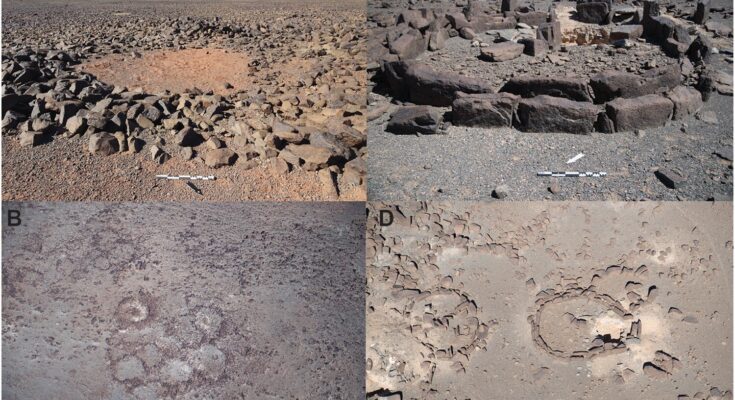Researchers in Saudi Arabia have made an exciting find. They dug up eight 7,000-year-old stone circles in Saudi Arabia.
These stone circles were found in a lava field called Harrat Uwayrid, close to the city of AlUla in the northwest part of Saudi Arabia. It is believed these were once used as homes, as reported by Archaeology Mag.
Aerial surveys have uncovered approximately 345 stone structures in the area. Each one measures between 13 to 26 feet across. These circles usually have at least one standing stone at the center. The remains of stone walls and at least one entrance can also be seen in these structures. The roofs were probably made of stone or natural materials.
Jane McMahon, a research expert at the University of Western Australia and the main author of the study, explained the significance of these 7,000-year-old stone circles found in Saudi Arabia. She noted that the earliest homes were typically circular in shape. Rectangular houses did not appear until later. McMahon shared these insights in a discussion with Live Science.
Total of 345 stone structures with one standing in the center
During their digs, archaeologists found many tools and pieces of debris made of basalt stone. In just five of these stone circles, they unearthed nearly 500 pounds of these stone tools. They also discovered bones from sheep, goats, and cows. This shows that the people who lived here long ago kept animals.
Archaeologists in Saudi Arabia have now excavated eight ancient stone circles that likely served as homes to people more than 7,000 years ago with remains of bones from sheep, goats, cows & hunting kill zones. pic.twitter.com/Q7BfSFAfnU
— Roland Baker (@RolandBakerIII) July 15, 2024
An especially interesting find was seashells from the Red Sea, which is about 75 miles away from AlUla. The presence of these seashells points to early trade and connections between different groups. According to the research team, these shells indicate growing trade networks and the movement of goods and people during the time.
The items found within these stone circles, along with their resemblance to ancient homes discovered in Jordan, suggest that many of these structures were used as dwellings. The architectural similarities point to a potential link between the communities in Saudi Arabia and Jordan.
Stone circles in Saudi Arabia from the time of no agriculture
These stone circles are from a period when northern Saudi Arabia was much wetter than today, yet agriculture had not been introduced.
Jane McMahon explained there’s no sign that people farmed domestic plants like wheat and barley. However, they likely gathered wild plants and might have even altered the landscape to improve the chances of these wild plants growing as well as their abundance.
During the same era, people also constructed another type of stone structure called mustatils, meaning “rectangle” in Arabic. These are thought to have been used for religious ceremonies and possibly even for the sacrifice of cattle.
The fact that mustatils and standing stone circles were used at the same time suggests they were part of the same cultural group. The research team noted that the simultaneous use of these two types of megalithic structures likely indicates they were both elements of a single cultural entity.



